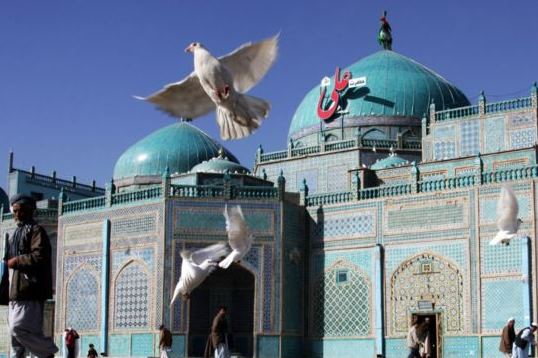Timeless Beauty of Blue Mosque in Mazar-e Sharif

What would Afghanistan look like without war?
It could look like the oasis of peace that is the Blue Mosque standing in its flower-filled park in the center of Mazar-e Sharif.
The block-sized park is surrounded by the noise of a modern city. It is girded on every side by streets with racing traffic, small shops, and sidewalk bazaars filled with crowds.
But as soon as you enter the park, the urban noise recedes. There is the laughter of children and the cooing of doves. Dozens of children with their parents and hundreds, no thousands, of snow white doves waddling across the rose-lined paths, pecking at the ground, and soaring overhead.
The white doves act like they live here and they do. They have been raised by the Blue Mosque's attendants since it was built in the 12th century and they have become one of its famous symbols.
Legend has it that the doves are pure white because of the sanctity of the mosque itself; if a dove with a speck of color flies in and stays, it too will turn white as snow.
To one side of the mosque complex is the pigeon house. It is a large, low concrete box with small windows and most of its space below ground. This is where the doves nest and breed year-round. It is also where they are fed.
On the building's flat roof, an old man is scattering seed by the tinful, appearing and disappearing in a cloud of white wings. But it is the Blue Mosque in the center of the park that rivets your attention.
It is truly blue, with its sides dressed in thousands of colorful and intricately patterned tiles that shimmer in the sunlight like a mirage. All the paths lead to it, and almost everyone who comes to the park visits it.
At the door of the mosque complex, you check your shoes and enter an ancient setting. Between prayers, families stroll the mosque's flagstone court and some visit the mosque's small museum. There are many pilgrims here, too, who have come from all over Afghanistan and beyond.
They believe they are visiting the tomb of Imam Ali (AS). The shrine forms the largest wing of the complex and can only be entered by the faithful. The shrine houses a tomb believed by some to be that of Imam Ali (AS).
People here believe his body was moved to Afghanistan from its original burial place in Najaf, Iraq, sometime early in the history of Islam.
The shrine has had a tumultuous history. It was destroyed by Genghis Khan and his Mongol army in the 13th century.
But it was rebuilt and has always been the most significant place of pilgrimage in Afghanistan, both for Shia and Sunni Muslims. When it is time for prayer, the sound of the muezzin's voice rings out over the mosque complex from one of the four corner minarets. It is possible to meet the muezzin as he leaves his room at the base of the minaret and joins the crowd heading to the prayer hall. Qari Shir Ahmad Ansari says he has been chanting the call to prayer at the Blue Mosque for 18 years and that his father did so before him.
Little has changed over the generations, he adds, apart from adding a loudspeaker system. In his father's time, four muezzins stood at the top of the minaret and called out in perfect unison, each facing a different direction. Then, just as today, the call could be heard across the center of the city.
Source: World Bulletin



